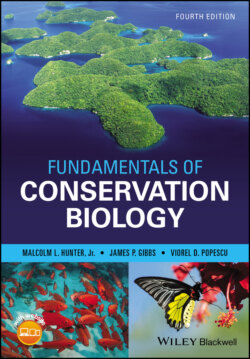Читать книгу Fundamentals of Conservation Biology - Malcolm L. Hunter Jr. - Страница 82
Strategic Values
ОглавлениеFrom the perspective of maintaining biodiversity at all levels – genes, species, and ecosystems – the single most essential value of ecosystems may be their strategic value. Conservation biologists have often proposed that by protecting a representative array of ecosystems, most species and their genetic diversity can be protected as well (Hunter 1991; Beier et al. 2015a). This idea is often described using a metaphor of coarse filters and fine filters first proposed by The Nature Conservancy (1982) (Fig. 4.8). The coarse‐filter approach to conserving biodiversity is appealing because it is efficient and provides broad protection. It is efficient because, compared with the number of species in the world, there are relatively few different types of ecosystems and thus protecting a representative array of these is comparatively straightforward. It is broad because it will protect, to some degree, little‐known species such as invertebrates and fungi, even undescribed species, plus their genetic diversity. The Nature Conservancy (1982) originally estimated that 85–90% of species could be protected this way, although this seems optimistic based on the few empirical tests that have been undertaken (e.g. MacNally et al. 2002; Grantham et al. 2010).
Figure 4.8 The strategic value of ecosystems is illustrated by the coarse‐filter–fine‐filter approach to conserving biodiversity. Protecting a representative array of ecosystems constitutes the coarse filter and may protect most species. However, a few species will fall through the pores of a coarse filter because of their specialized habitat requirements or because they are overexploited. These species will require individual management, the fine‐filter approach. In this example, a coral reef ecosystem with all of its constituent species is protected by the coarse‐filter approach, but fine‐filter management is still required for the hawksbill turtle and spiny lobster.
Importantly, the coarse‐filter approach can be an effective strategy regardless of whether ecosystems are tightly connected systems or loose assemblages of species (Fig. 4.3). It is only necessary that the distribution of species and their habitats have some degree of concordance so that a complete array of ecosystems will harbor a reasonably complete array of species (Hunter et al. 1988; Rodrigues and Brooks 2007). We will return to this point and the coarse‐filter approach in general in Chapter 11, “Protecting Ecosystems.” Finally, it is notable that some ecosystems are analogous to flagship species; that is, they elicit public concern about conservation writ large. Tropical rain forests and coral reefs are perhaps the best examples of this phenomenon, but others, such as traditional agricultural ecosystems with high cultural value, are emerging as a new emblem for biodiversity conservation (Chapter 14, “Conservation near People”).
